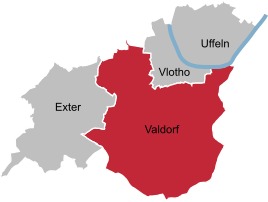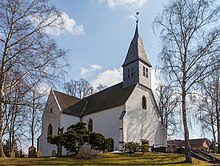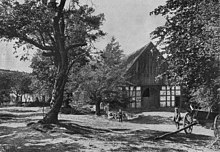Valdorf (Vlotho)
|
Valdorf
City of Vlotho
Coordinates: 52 ° 8 ′ 31 ″ N , 8 ° 51 ′ 20 ″ E
|
|
|---|---|
| Height : | 111 (110-342) m |
| Area : | 38.97 km² |
| Residents : | 5332 (December 31, 2018) |
| Population density : | 137 inhabitants / km² |
| Incorporation : | 1st January 1969 |
| Postal code : | 32602 |
| Area code : | 05733 |
|
Location of Valdorf in Vlotho
|
|
Valdorf is the largest and the southernmost district of the East Westphalian town of Vlotho in the Herford district . Valdorf has around 5332 inhabitants (as of December 1, 2018).
General
In the pre-Napoleonic times, the area of today's district of Valdorf formed the church of Valdorf and politically the Vogtei Wehrendorf (also called Vogtei Valdorf ) in the Vlotho district of the Ravensberg county . The parish of Valdorf has always included the five farmers Bonneberg, Hollwiesen, Steinbründorf, Valdorf and Wehrendorf. In the province of Westphalia founded in 1815 , the parish Valdorf belonged to the administrative district of Vlotho in the Herford district. As part of the introduction of the rural community order for the province of Westphalia in 1843 the farmers of the parish of Valdorf were combined to form the political municipality of Valdorf.
On January 1, 1969, Valdorf was incorporated into Vlotho.
In the Steinbründorf area is the Bonstapel, the highest mountain in the Herford district . The proportion of agricultural use is very high, there is a high density of settlements along the Forellenbachtal (Rahlbruch) and parallel to it on the heights on the right-hand side (including Horst). In the Rahlbruch there is a high density of service providers with an offer for daily living needs. In addition to a larger department store with a beverage store, the Minske store opened in 2008 with its range of discounters should be mentioned.
The area around the Bonneberger Church and dense residential development in the Winterberg and Bretthorst areas are still to be mentioned as settlement centers. In the southern area there is a large amount of forest in comparison to the Herford district, which is poorly forested on average.
The Hans-Schwarze-Grundschule in the Topsundern is located in the Valdorf area and the school center at the Jägerort is located on the outskirts of the Vlotho district. The Bonneberg part of the Vlotho elementary school (Herford Street) is located near the church.
For a better overview, the essential areas of the three parishes that used to be in the Valdorf area are described below with their characteristics. They go back in their entirety to the old Vogtei Wehrendorf (also known as Vogtei Valdorf).
As of October 1, 2017, the district of Valdorf had 5,414 inhabitants.
Bonneberg
The former farmers in the north of Valdorf was named after the Bonneberg . For the year 1282, a file on the Vlotho monastery can be read of a farm on the Bonneberg. This part of the Vlotho district of Valdorf is mainly concentrated in the further intersection area Loher Strasse / Bonneberger Strasse.
The Evangelical Lutheran Jubilate Church , built and consecrated in 1957, can be found on the latter . Until then, the Bonnebergers were dependent on the Valdorfer Church. In 1970 they got their own parish. On September 1, 2019, this was merged with the Evangelical Lutheran parish of Exter to form the "Parish of Exter Bonneberg", with both churches being mutually open for regular services in the future. The parishioners are currently being looked after by the pastors of the formerly independent parish of Exter and the parish of Valdorf. The Bonneberg Church has its own cemetery.
The settlement structure in the above-mentioned core area consists primarily of residential developments. In the Bonneberg district, a Protestant kindergarten and a primary school are offered. There is an owner-run guest house with a hotel. At the former location of a bed and bedroom factory that was closed in 1988, there is now an upscale meeting and conference hotel under the name “Essential by Dorint Herford Vlotho”. The former furniture factory was an important employer in the region. Through the western part of the town, the highway runs A 2 .
Valdorf
The actual Valdorf is first mentioned in 1055 as Valethorpe . It is located within the Vlotho district of the same name to the south and north of the villages of Bonneberg and Wehrendorf and was temporarily divided into Valdorf-West and Valdorf-Ost after the First World War, but both of which were administered together.
Valdorf-West

The Gothic church in Valdorf celebrated its 750th anniversary in 2008. In Valdorf, next to the church, there is the Simeonsstift nursing home for the elderly, which was founded by pastor Eberhard Delius, who was one of the superintendents of the earlier Vlotho synod, who worked in the village from 1868 to 1897. He was the successor to pastor Karl Kuhlo , who was active from 1851 to 1868 , and whose nephew Johannes Kuhlo is still commemorated today as the Trumpet General of the Ravensberg Awakening Movement.
The spa facilities Bad Seebruch (Weserlandklinik) and Bad Senkelteich (Moorland-Klinik) are located in this area. They developed from farm baths that were built in the 19th century, a tradition that especially Bad Senkelteich continues. Occasion was the presence here sinkholes with their rich Torfmoorvorkommen. The last break-in occurred in 1970 on the Bad Seebruch site, people were not harmed. Are in continued on an axis to the border area Steinbründorf / Bentorf (municipality Kalletal) with several no longer clearly recognizable sinkholes on Bentorfer area several sometimes very deep or extensive sinkholes at the local Lichtensberg .
In the former elementary school Valdorf, under the sponsorship of the Weserlandklinik, physiotherapists are trained in a state-recognized training institution. Bad Seebruch works with a focus on rehabilitation, orthopedics and rheumatology, Moorland Bad Senkelteich offers u. a. Rheumatism, skin, sleep and women cures, also a wellness offer is available. In the catchment area is the forest outdoor pool built by the local sports club in 1951/2, which is one of the few public outdoor pools in the region that still has a 50 m swimming pool.
On the left side of the current flowing through the Rahlbruch trout stream located on the border with Bonneberg a hill named Hünenburg , follows the successful excavations mid-1990s, the existence of an ancient hill fort could be detected. From 1535 to 1958 at the latest, high-quality building lime was mined and burned on the slope of the Hünenburg. For a short time there was a swimming pool in the so-called steel spring in the 19th century . In the Ravensberger Urbar of 1556 there is a report of a dilapidated iron and smelting mill , in 1641 the ducal office of Düsseldorf approved the operation of a paper mill here, which was operated under various changes of ownership until 1966. Next to it is the Vlotho rescue center and the volunteer fire brigade.
Important for the region coveted for building local was travertine , which after the mining area, the hallway Valdorfer Horst as Horst Stein was named. In Brandenburg times it was shipped to Indonesia. In and around Valdorf / Vlotho there are still many buildings that were built from this easy-to-work, but light and stable material.
On October 17, 1638, a battle of the Thirty Years' War took place near the Eiberges, which lasted only a few hours . The event went down in history as the Battle of Valdorf (or Battle of Vlotho).
Valdorf-Ost
In contrast to the western part, in this part there were mainly agricultural holdings of different sizes, which resulted in loosened settlement. On the Winterberg in Valdorf-Ost, a two-class elementary school was set up in 1892, which was jokingly referred to as "Vlothos Adult Education Center" because of its altitude. Before that, the schoolchildren in the corresponding catchment area visited the existing school near the church in the Valdorf community, which sometimes involved traveling times of up to three and a half hours. After the school restructuring in what was then Amt Valdorf, Werner Georg Haverbeck acquired the property in 1963 and later founded the right-wing extremist Collegium Humanum here . It was closed in May 2008 by the Federal Minister of the Interior.
Wehrendorf

Wehrendorf adjoins the area of the parish Valdorf to the southwest and was the namesake for the Bailiwick of Wehrendorf in medieval times. It was founded around 900 and it is reported that it used to be a junction of old trade routes from Lemgo to the Weser . A customs post with a subordinate named Johan Kriger is documented for 1556. It could have been in the area of today's Waddenbergstrasse, where descendants of the named still live.
For about two centuries it was the center of the parish of the same name. A church or chapel in Wehrendorf is mentioned around 900. How long it was used is not known, in 1828 an object known as the ruin of the old church was demolished. The presumed remains were uncovered in 2019 by archaeologists from the Landschaftsverband Westfalen-Lippe (LWL) following targeted information. It is also known that there was a cemetery in the vicinity. Whether and to what extent the relatively nearby Valdorf Church (mentioned for the first time in 1258) was also used by the people of Wehrendorf is still unclear. The rectory, from which the clergyman responsible for the church in Valdorf acted, was still in Wehrendorf. Today's parish hall in Valdorf was not built until around 1890, also with considerable financial commitment from the pastor Eberhard Delius.
In 1969 the people of Wehrendorfer received their own suitable church, the Kreuzkirche , which had previously stood as a so-called emergency church in Bad Oeynhausen since 1951 . After the construction of the Resurrection Church there , it continued to serve its purpose here. According to Grossmann, in addition to Wehrendorf, church services were held on site in the confirmation hall for the surrounding farmers in Hollwiesen, Bonneberg and Steinbründorf around 1955. In 1828 the still existing wooden bell tower, which is now a listed building, was built at the parish hall.
Adjacent to the former municipality of Valdorf is the old Hollwiesen farming community, where the first systematically planned and designed industrial area of the same name was created after the Second World War. It was here that the Herbert Kannegiesser GmbH laundry machine factory developed from small beginnings, with a worldwide reputation. There are other industrial settlements east of the Neue Landstrasse leading towards Bad Salzuflen (Wüsten district) . Mention should be made of the Steinmann organ building workshop in Wehrendorf, which celebrated its centenary in 2010 and is represented with its instruments far beyond the borders of East Westphalia even as far as Africa.
In the south of the former peasantry Steinbründorf there are the highest elevations of Vlotho and thus in the Herford district. Especially the Bonstapel on the Lippe border, around which several nature reserves are grouped, offers an extensive network of hiking trails. The Bonstapel nature trail, managed by the local Hegering, has been implementing the concept of modern museum education since 1994.
The Linnenbeeke rises from seven springs on the Bonstapel and flows north to Vlotho and merges into the trout stream that flows into the Weser in the Valdorf district . Near the first station of the above-mentioned nature trail, there are traces of an old Saxon farmhouse on the left of the Linnenbeeke. The homestead shown in the picture from 1909 should have stood in this area.
literature
- Karl Grossmann : History of the community of Valdorf and its farmers , Valdorf 1955, without ISBN.
- Karl Grossmann: History of the Office Vlotho . 1246-1963. Vlotho 1963.
- Manfred Kluge: 950 years of Valdorf , Vlotho 2005, publisher Vlotho Marketing, Vlotho.
- Ch. Beyer et al. a .: 750 years of the church in Valdorf , Vlotho 2008, series of contributions to local history , history workshop Exter, ISSN 1619-7828 and other issues in the series.
Individual evidence
- ↑ a b Figures - Data - Facts: Population. In: Vlotho. December 31, 2018, accessed April 10, 2020 .
- ↑ Statistical-topographical overview of the government district of Minden 1821. In: Digital Collections ULB Münster. P. 38 ff , accessed on March 3, 2014 .
- ^ Official Journal of the Minden Government: Constitution of the offices and their communities in the Herford district. Retrieved February 2, 2014 .
- ↑ geschichtevlotho.de: History of Valdorf
- ↑ Martin Bünermann: The communities of the first reorganization program in North Rhine-Westphalia . Deutscher Gemeindeverlag, Cologne 1970, p. 75 .
- ^ City of Vlotho: Numbers, data, facts. Retrieved May 21, 2014 .
- ↑ Wolfgang Mager: The Urbar of the Grafschaft Ravensburg from 1556. Part 3, Münster 1997, ISBN 3402068141 , p. 320
- ^ History workshop Exter, contributions to the local history F05 “Jugs, pubs, breweries” 1995, p. 14, ISSN 1619-7828
- ↑ Westfalenblatt, Bielefeld, regional edition "Vlothoer Zeitung", July 5, 2019, p. 9
- ^ Karl Grossmann: History of the community of Valdorf and their farmers, Valdorf 1955, p. 213ff, without ISBN.
- ↑ Bonstapel nature trail. (PDF; 4.6 MB) Retrieved February 6, 2013 .






